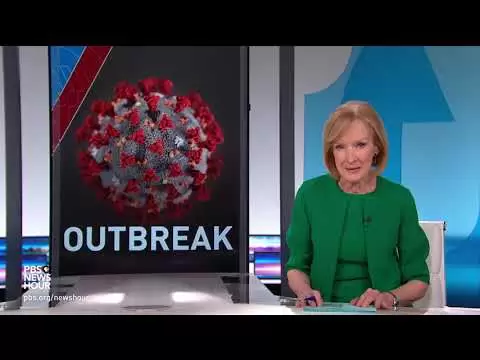How U.S. health officials are responding to the threat of novel coronavirus
Feb 18, 2020JUDY WOODRUFF: And now back to our main story: There are more questions today about the fate of Americans aboard two cruise ships caught in the global
coronavirus
crisis. Amna Nawaz has the latest. AMNA NAWAZ: Cheryl and Paul Molesky didn't imagine their cruise vacation like this. CHERYL MOLESKY, QUARANTINE Passenger: We've been in this room on the Diamond Princess for the past 27 days. For the past 12 days, we haven't set foot in the hallway. AMNA NAWAZ: The couple from Syracuse, New York, were among more than 300 Americans quarantined on the ship in Yokohama, Japan. The ship, with 3,700 passengers and crew, has been docked in Japan for 12 days.More than 450 people have tested positive for the
coronavirus
, making it the largest cluster of cases outside of China. But on Sunday night, U.S.officials
evacuated 340 Americans who had been freed from the ship, including the Moleskys, and brought them back to the United States. CHERYL MOLESKY: It's a little scary about the increase in the number of people being taken off the ship with the COVID-19 virus. So, you know, I think it's time to go. I think it's time to cut our losses and take off. AMNA NAWAZ: The two evacuee flights landed early today at military bases in northern California and Texas.
More Interesting Facts About,
how u s health officials are responding to the threat of novel coronavirus...
They now face another 14 days of quarantine. Meanwhile, the World Health Organization said it is working closely with Japanese
officials
to prevent a larger outbreak. DR. SYLVIE BRIAND, World Health Organization: We need to make sure that we focus on our goal, the publichealth
goal, which is to contain the virus, and not contain people, and make sure that we can strike the right balance between thehealth
of the population in Japan and other countries, but also the health of the people currently on this ship. AMNA NAWAZ: Late last week, the Westerdam cruise ship was finally allowed to dock in Cambodia, after five countries rejected it.One passenger, an American, then traveled to Malaysia, where days later she tested positive for the virus. Hundreds of people freed from the ship have already headed to their home countries and have been warned to quarantine. In China, health experts say the outbreak may be stabilizing. Some workers returned to jobs in Beijing and Shanghai today as two-week quarantines in the cities expired. HU SHAOLIE, Shanghai (via translator): The elevator is disinfected every two hours and you need to take your body temperature and record it before entering that building, and then take it at another time before entering the office.
So I don't think fear is necessary. AMNA NAWAZ: The Chinese government said today that more than 10,000 patients who have been hospitalized with the virus have recovered and been discharged. GUO YANHONG, National Health Commission (via translator): Across the country except Wuhan, the number of newly diagnosed cases has been declining for 13 consecutive days. These are really good signs that our prevention and control efforts have worked very well. AMNA NAWAZ: WHO scientists are now in China, working with officials there to investigate the spread of the virus. The Centers for Disease Control said the decision to repatriate Americans from the ship in Japan came after an increase in the number of new coronavirus cases on board.
So how well is quarantine working? And what are the risks after those who have been isolated return to the general population? For that and more, I'm joined by Dr. William Schaffner, professor of infectious diseases at Vanderbilt University School of Medicine. Dr. Schaffner, thank you for being with us. And welcome to the "NewsHour." I want to ask you how health officials are handling these cases. When you look at the first case from a cruise ship, you have hundreds of people deciding to evacuate and fly back to the United States, even after some of them tested positive for the virus.
Are they handling this the right way? DR. WILLIAM SCHAFFNER, Chair of the Department of Preventive Medicine, Vanderbilt University: Oh, I think our officials, Amna, are handling the circumstances very, very well. They have well-prepared places where these quarantined people will go. They are providing excellent clinical care to people who have been diagnosed with the virus. And I think we're still in the containment phase here in the United States. Let's find everyone, diagnose quickly and then public health can work with all contacts. So I think our officials have this under control. AMNA NAWAZ: Well, what about the rest of the world now?
We also just told the story of that second cruise. She was allowed to dock in Cambodia. You have hundreds of passengers who have disembarked and already gone to other places, that known case of a positive coronavirus test that we know about. What are your concerns when it comes to that? DR. WILLIAM SCHAFFNER: Yes. Well, Amna, I'm a little more worried, because there is confusion and there was no coherent policy. People who have been exposed have now traveled to many parts of the world. I hope they are being identified. And I hope local public health officials reach out to them and keep them under surveillance.
I'm not sure that's happening. And now we have the possibility of small individual outbreaks starting in other countries, because if those people get infected, they could start chains of transmission in other countries. That wouldn't be good at all. AMNA NAWAZ: Tell me a little bit about what we know about quarantine standards. We have heard a lot from the passengers here who have had to go through that 14-day quarantine, some very emotional stories that they also tell, one woman said: I feel like I have lost a month of my life, after 14 days of quarantine in Japan and 14 more days back to the United States.
What is that quarantine like? And do you know if other countries are standardizing it in some other way? DR. WILLIAM SCHAFFNER: I don't think there is any standardization. But I'm certainly sorry and I take my hat off to all the people who have been in quarantine. It must be very, very boring. The rest of your life goes on and you can only deal with it through your iPhone, and it must be very, very difficult. Also, you are isolated or semi-isolated, so there is not much interaction with other people. It is not a very pleasant experience. You are being imprisoned by a virus.
AMNA NAWAZ: I have to ask you, Dr. Schaffner. There is a lot we still don't know about the virus, but there are a number of theories that are circulating and being shared. And I would like to know your opinion about them to ensure that we are conveying the right information to our audience. There is some skepticism, it is fair to say, around the information coming from the Chinese government, where the virus is believed to have originated, in China. And there was this moment from Arkansas Senator Tom Cotton, who gave an interview on FOX News yesterday. And they asked him about the origins of the virus.
Listen to this. SEN. TOM COTTON (R-AR): We don't know where it originated. But we do know that we have to get to the bottom of this. We also know that just a few kilometers from that food market is China's only biosafety level four super laboratory researching human infectious diseases. Now, we have no evidence that this disease originated there, but because of China's duplicity and dishonesty from the beginning, we need to at least ask the question. AMNA NAWAZ: Dr. Schaffner, what is your response to that? DR. WILLIAM SCHAFFNER: Well, it is an issue that needs to be addressed.
But I have to say that there are no scientists or public health officials around the world who think that this is a virus that somehow escaped from a containment facility. This is a virus, just like the SARS virus and the MERS virus, the Middle East respiratory syndrome viruses, these were coronaviruses that reached humans through animals. That's what happened with this case. AMNA NAWAZ: However, to Senator Cotton's point, we've heard this before. There is skepticism regarding the information coming from the Chinese government. Do you trust that the figures coming from the government are reliable? DR. WILLIAM SCHAFFNER: Well, the number of cases coming from China has changed over time because their case definition has changed.
I think they're trying to do a good job, but it's still very confusing and we have to be skeptical. We don't know if the outbreak in Wuhan and other parts of China continues at the same rate, increasing or, my goodness, it could be decreasing. The numbers are not yet consistent enough for us to draw firm conclusions. AMNA NAWAZ: Well, to that point, we just heard today that the Chinese government says that there was actually a drop in the number of cases. If that's true, what would that tell you about the possible future spread of the virus?
DR. WILLIAM SCHAFFNER: Well, if that's true, and I certainly hope it is, it would mean that this huge public health experiment that they've done, quarantining between 11 and 50 million people, actually had some impact on reducing the transmission of the virus. I've always hoped for that. I hope it's correct and then we can start planning the ending. When can we start to get things back to normal? But it is too early to be sure that we will be able to achieve it. We can hope for the best, but we have to continue preparing for the worst. AMNA NAWAZ: Dr.
Schaffner, there are only a few seconds left. I have to ask you. Just a week ago, scientists were saying there is still a chance of a global pandemic. Based on what we've learned in the last week, do you think that's still the case? DR. WILLIAM SCHAFFNER: The potential is there, Amna. Whether we will get there or not, we don't know. I'm holding my breath and crossing my fingers. AMNA NAWAZ: Dr. William Schaffner from Vanderbilt University School of Medicine, thank you very much. DR. WILLIAM SCHAFFNER: Thank you.
If you have any copyright issue, please Contact









